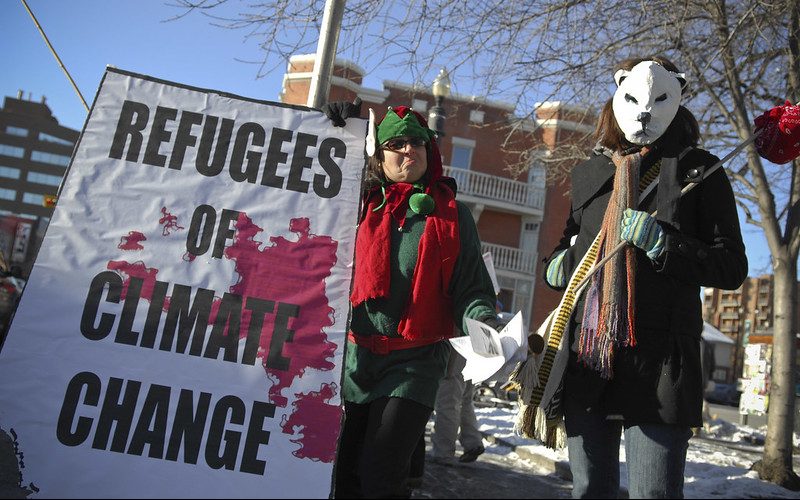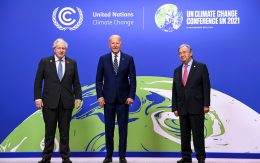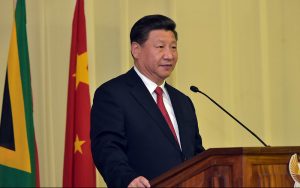A month ago, the people of Cuba and Southeast USA were ravaged by one of the most devastating hurricanes in the Americas since Katrina – Hurricane Ian. The reverberations resulted in massive power outages and the destruction of homes to millions, costing damages worth over $67 billion and 100+ confirmed deaths. On the other side of the world, the floods in Pakistan, Mexico, Niger, and Nigeria washed away the lives of millions. Rising sea levels are engulfing micro islands such as Micronesia and Kiribati, leaving their residents without a home or a country to call their own; In 50 years, these countries will be a name from the past.
As these catastrophes arrive at our doorsteps, we are witnessing news channels and websites swarmed with headlines of unprecedented disasters ensuing across the world. Millions lose their loved ones, are displaced, unemployed, and hopeless. The cause? Climate Change.
Presently, every country around the world experiences ‘natural’ disasters each year – without fail. In the Americas, they are met with floods and earthquakes; In volcanic regions, mountains which have remained dormant for decades and centuries are bubbling up again; In Africa, their rivers are parched; In Australasia, wildfires are the norm; and in Asia, a mixture of all. As the livelihood of billions is despoiled, one question arises: where will the climate refugees go?
Climate refugees are defined as people who have been forcefully displaced as they fall victim to the repercussions of climate change on their environments. Although climate refugees are not officially recognized under international law and are barely discussed in mainstream media and politics, it is estimated that around 1.2 billion people will attain climate refugee status by 2050. According to Internal Displacement Monitoring Center (IDMC), 30.7 million people were dispossessed due to environmentally-related disasters in 2020, three times more than ones affected by armed conflict and violence and the highest levels of displacement linked to climate change. Other related statistics published by the same NGO suggest that since 2008, over 318 million people have been forcibly displaced by climate disasters, equivalent to one person being displaced every second. The affliction undergone is not equally distributed either. The Global South will share substantial torment, with Latin America generating 17 million climate migrants, South Asia with 40 million, and Sub-Saharan Africa with 86 million people.
Within the community of climate refugees, there are various degrees of the magnitude of vulnerability to the crisis. Refugees of other calamities, internally displaced people (IDPs) and the stateless are on the frontlines of the climate emergency, facing twice the blow. Many are living in climate “hotspots”, where they typically lack the resources to adapt to an increasingly hostile environment.
For people whose livelihoods are closely linked to the stability and health of their environment – such as farmers and fishers – migration is necessary for survival. As people in the hottest regions migrate to the colder regions, they may be subjected to racism, sexism, and xenophobia. Particularly in reference to the rising support of far-right in Northern countries who spout eco-fascist remarks. The current general refugee population is burdensome to the international community. The climate crisis is exacerbating these numbers and pressurizing countries with relatively livable climates (temporarily) to welcome them, hindering development and increasing tensions within society. It also pushes its citizens towards conservatives who promise to close the borders. This is the present situation transpiring in Europe. The increase in migrant (non-white) populations across the continent have provided right-wing parties with the advantage of increasing their mass following by disseminating xenophobic, racist, and sexist ideas.
While Europe and North America are casualties of unprecedented levels of heat as the planet warms and other climate-related disasters, it is incomparable to the devastation caused in the global South and its inability to recover. Nevertheless, the EU Parliament are progressively concerned by forced displacements occurring within its region. According to the IDMC, 37,700 people were forcibly displaced within the EU because of climate disasters in 2020 alone. The main culprit was wildfires, engendering 21,000 displacements due to extreme temperatures and drought.
The migration towards ‘lesser affected’ areas of the world will swell population density in certain cities, which could spark the collapse of public infrastructures such as healthcare, education, law enforcement and security, and more. Certain types of refugees (legally recognized) will also receive priority for protection; these include political asylum seekers, war refugees, ethnic/racial refugees, etc. Hence, climate refugees will have to ‘compete’ for a place in the ‘safer’ society.
The depletion of water availability due to rising temperatures will also reduce water quality, increasing risks of spreading illnesses as well as droughts from crop failures. This will impact incomes as well as food supplies. As the probability of pandemics augment, so does the number of climate refugees, expanding the threat of people dying as they are compelled to choose between protection from the virus or the calamity. For instance, when an earthquake hit Croatia on December 28, 2020, it killed eight and displaced over 2,000. Authorities had to juggle between the disaster and the pandemic, fearing an increase in COVID-19 infections as two of the six temporary housing shelters were placed under quarantine. Many others chose to stay in their homes to avoid catching the virus.
Climate-related desertification of parts of fertile Syria between 2006 and 2010 ultimately culminated in the civil war as crop yields dropped and food prices soared, 800,000 people lost their income, and 85% of the country’s livestock died. 1.5 million rural workers moved to the city to find jobs, while those who remained became easy targets for recruiters from the Islamic State.
As the number of climate migrants proliferates, it is imperative for governments to formulate an effective plan to receive and allocate them to safer regions. Nonetheless, NGOs and supranational governments are working towards implementing policies and ensuring climate refugees are officially recognized as such by the likes of the UN and national governments. The acknowledgement will open room for further protection of displaced victims.
To answer the question initially posed, climate refugees will have nowhere to go. We all run the risk of continuing life as vagabonds, depending on the grounds we walk on to be our temporary abode while we mobilize across all directions in search of better conditions. As more countries are consumed by extreme heat, flooding, and earthquakes, humanity will have no choice but to surrender to its planet.
Sources Davies, R. (2022) ‘Mexico – Fatalities Reported After Heavy Rain and Floods in 6 States’ Flood List [online] available from <https://floodlist.com/america/mexico-floods-august-2022> European Parliament (2021) The Concept of ‘Climate Refugee’: Towards a Possible Definition [online] available from <https://www.europarl.europa.eu/RegData/etudes/BRIE/2021/698753/EPRS_BRI(2021)698753_EN.pdf> European Parliament (2022) EPRS Policy Talks: What does the EU on ‘Climate Refugees’? [online] available from <https://www.europarl.europa.eu/thinktank/fr/events/details/eprs-policy-talks-what-does-the-eu-on-cl/20220929WKS04401#:~:text=According%20to%20statistics%20published%20by,person%20being%20displaced%20every%20second.> Flood List (2022) Niger [online] available from <https://floodlist.com/tag/niger> Freedman, A. (2022) ‘Hurricane Ian may have caused $67 billion in damage, a top 5 U.S. storm’, Axios [online] available from <https://www.axios.com/2022/10/07/hurricane-ian-damage-estimate-costliest-storm-florida> Habeshian, S. (2022) ‘Hurricane Ian is Florida’s deadliest in nearly a century’, Axios [online] available from <https://www.axios.com/2022/10/07/hurricane-ian-deadliest-florida> Iberdrola (2022) Kiribati, the first country rising sea levels will swallow up as a result of climate change [online] available from <https://www.iberdrola.com/sustainability/kiribati-climate-change> International Federation of Red Cross (2020) Croatia: Potential COVID-19 spread in temporary shelters concerns in aftermath of killer earthquake [online] available from <https://www.ifrc.org/press-release/croatia-potential-covid-19-spread-temporary-shelters-concerns-aftermath-killer> Kidera, M. & Hosokawa, R. (2022) ‘Climate Refugees: The World’s Silent Crisis’, Nikkei Asia [online] available from <https://asia.nikkei.com/Spotlight/Datawatch/Climate-refugees-The-world-s-silent-crisis> Malay Mail (2022) Nigeria floods toll has passed 600, says government [online] available from <https://www.malaymail.com/news/world/2022/10/17/nigeria-floods-toll-has-passed-600-says-government/33994> The World Bank (2021) Climate Change Could Force 216 Million People to Migrate Within Their Own Countries by 2050 [online] available from <https://www.worldbank.org/en/news/press-release/2021/09/13/climate-change-could-force-216-million-people-to-migrate-within-their-own-countries-by-2050> UNICEF (2022) Devastating Floods in Pakistan [online] available from <https://www.unicef.org/emergencies/devastating-floods-pakistan-2022> Zurich (2022) There could be 1.2 billion climate refugees by 2050. Here’s what you need to know [online] available from <https://www.zurich.com/en/media/magazine/2022/there-could-be-1-2-billion-climate-refugees-by-2050-here-s-what-you-need-to-know>








Be First to Comment